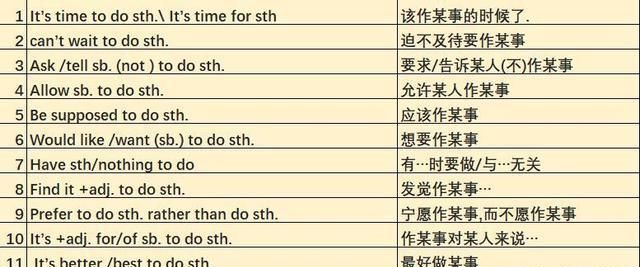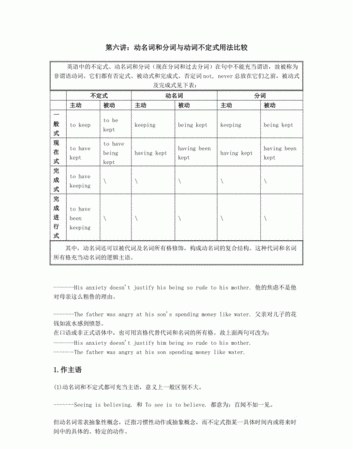本文目录
动名词的用法
动名词,指的是动词ing形式的一种,兼有动词和名词特征的非限定动词。它可以支配宾语,也能被副词修饰。动名词有时态和语态的变化。英语中的动名词是由动词变化而来。
1) 动名词做主语时,谓语动词为单数
2) 在动名词和不定式中,作为介词的宾语是动名词
3) 动名词的否定直接在其前加否定词,通过代词的宾格或所有格形式给出逻辑主语
问问题之前好好搞清楚什么是动名词

动名词使用方法及举例
感谢您关注智课网(SmartStudy)
同学您好:
(一)做主语和表语。动名词短语用and连起来做主语时,谓语用复数形式。
(二)动名词短语作宾语。
(三)动名词短语作介词宾语的时候最多。尤其是在短语动词后面。
(四)动名词也可以有自己的逻辑主语,就是在动名词短语前面加上物主代词或名词的所有格。带逻辑主语的动名词短语可做主语,宾语,表语等。在非正式文体当中,经常把物主代词简化为宾格人称代词,把名词所有格简化为名词。
(五)动名词的完成式和被动语态:
(1)完成式表示动名词的动作发生在谓语动作之前。
(2)当动名词的逻辑主语是动名词动作的对象或承受者时,动名词要用被动语态。
(六)某些动词可接不定式也可接动名词做宾语,但意义有差别。
(1)like, love,hate, prefer等表示喜爱,厌恶的动词后面,可用动名词也可用不定式作宾语,意义差别不大。但当这些词前面有should或would时,一定要用动词不定式作宾语。表示想要,愿意,打算。
(2) forget to dosth.忘记去做某事(未做)
forget doing sth.忘记做过某事(已做)
(3)remember to dosth.记着去做某事
remember doing sth. 记得做过某事
(4)stop to do sth. 停下来去做另一件事
stop doing sth. 停止做某事
(5) regret to dosth. 对尚未做的或正在做的事情表示遗憾;
regret doing sth. 对已做的事情表示后悔
(6)try to do sth努力去做某事
try doing sth.做某事试一试
(7) mean to do sth.打算、意欲做某事
mean doing sth.意味着做某事
(8) go on to dosth.做了一件事又去做另一件
go on doing sth继续做原来的事情
想获取更多学习资料可关注:***/index.html

动名词的用法是什么
动名词
一.概念
动名词是非限定动词的一种形式,由动词原形+ing构成.它既有动词的特征,又有名词的特征,故称.动名词也有时态和语态的变化,如表所示(以及物动词write为例),不及物动词没有语态的变化.
时态/语态
主动
被动
一般式
writing
being written
完成式
having written
having been written
二.相关知识点精讲:
1.作主语.例如:
Fighting broke out between the South and the North.南方与北方开战了.
2.作宾语
a.有些动词可以用动名词作宾语.例如:
admit 承认
appreciate 感激
avoid 避免
complete完成
consider认为
delay 耽误
deny 否认
detest 讨厌
endure 忍受
enjoy 喜欢
escape 逃脱
fancy 想象
finish 完成
imagine 想象
mind 介意
miss 想念
postpone推迟
practice 训练
recall 回忆
resent 讨厌
resume 继续
resist 抵抗
risk 冒险
suggest 建议
face 面对
include 包括
stand 忍受
understand 理解
forgive 宽恕
keep 继续
例如:Would you mind turning down your radio a little,please?你把收音机音量调小一点,好吗
The squirrel was lucky that it just missed being caught.这松鼠幸运得很,刚逃避了被逮住的厄运.
b.有些结构后面可以用动名词作宾语或其他成分.例如:
admit to
prefer…to
be used to
lead to
devote oneself to
object to
stick to
no good
no use
be fond of
look forward to
be proud of
be busy
can't help
be tired of
be capable of
be afraid of
think of
burst out
keep on
insist on
count on
set about
put off
be good at
take up
give up
be successful in
3.作表语,对主语说明、解释.例如:
Her job is washing,cleaning and taking care of the children.她的工作是洗刷、清扫和照顾孩子.
比较:She is washing,cleaning and taking care of the children.
4.作定语,一般表示所修饰名词事物的用途.例如:
a writing desk=a desk for writing 写字台
a swimming pool=a pool swimming 游泳池
有些动名词作定语,与所修饰的名词关系比较复杂.例如:
boiling point=a temperature point at which something begins to boil 沸点
a walking tractor=a tractor which a driver can operate while he or she is walking behind it 手扶拖拉机
5.动名词复合结构
物主代词/人称代词或名词所有格/普通格与动名词连用,就构成了动名词的复合结构.物主代词或名词所有格等是动名词的逻辑主语.
动名词复合结构在句中主要作主语和宾语.
The students' knowing English well will help them to learn French.学生学好了英语对学习法语有帮助.
I remember Tom's going there.我记得汤姆去过那里.
三.巩固练习
1.It’s no use __________ theory without practice.
A.to learn B.of learning C.learn D.learning
2.Talking is easier than ______.
A.more doing B.to do C.doing D.much doing
3.Seeing it,he couldn’t help _______.
A.shouting B.shouting at C.shout D.his shouting
4.We insisted on ________ a good lesson.
A.teach B.her teaching C.teaching her D.himself teaching
5.Tom has got used to _________ Chinese.
A.to speak B.speaking C.to speaking D.to saying
6.The patient has given ________.
A.smoking B.out smoking C.smoke D.up smoking
7.The book is well worth ________ a second time.
A.reading B.seeing C.looking D.watching
8.Anybody won’t stand _______ like that.
A.to laugh B.being laughed at C.being not laughed at D.to laughing at
9.He admitted _________ Mary to that fellow.
A.having married B.to have married C.marrying not D.being married
10.Do you mind _________ a little late?
A.my being B.I being C.me to be D.be
11.The beautiful flowers want ________.
A.having watered B.watering C.being watered D.waters
12.She prefers ________ at home to _______ out at night.
A.to stay; go B.going; staying C.staying; going D.to staying; go
13.Would you mind _________ alone at home?
A.left B.being left C.to be left D.leaving
14.The squirrel was lucky that it just missed _______.
A.catching B.to catch C.being caught D.caught
15.I can hardly imagine Peter ________ across the Atlantic Oceanin five days.
A.sail B.to sail C.sailing D.to have sailed

动名词的用法总结
动名词
一. 概念
动名词是非限定动词的一种形式,由动词原形+ing构成。它既有动词的特征,又有名词的特征,故称。动名词也有时态和语态的变化,如表所示(以及物动词write为例),不及物动词没有语态的变化。
时态/语态
主动
被动
一般式
writing
being written
完成式
having written
having been written
二. 相关知识点精讲:
1.作主语。例如:
Fighting broke out between the South and the North. 南方与北方开战了。
2.作宾语
a. 有些动词可以用动名词作宾语。例如:
admit 承认
appreciate 感激
avoid 避免
complete完成
consider认为
delay 耽误
deny 否认
detest 讨厌
endure 忍受
enjoy 喜欢
escape 逃脱
fancy 想象
finish 完成
imagine 想象
mind 介意
miss 想念
postpone推迟
practice 训练
recall 回忆
resent 讨厌
resume 继续
resist 抵抗
risk 冒险
suggest 建议
face 面对
include 包括
stand 忍受
understand 理解
forgive 宽恕
keep 继续
例如:Would you mind turning down your radio a little, please? 你把收音机音量调小一点,好吗
The squirrel was lucky that it just missed being caught. 这松鼠幸运得很,刚逃避了被逮住的厄运。
b. 有些结构后面可以用动名词作宾语或其他成分。例如:
admit to
prefer…to
be used to
lead to
devote oneself to
object to
stick to
no good
no use
be fond of
look forward to
be proud of
be busy
can't help
be tired of
be capable of
be afraid of
think of
burst out
keep on
insist on
count on
set about
put off
be good at
take up
give up
be successful in
3.作表语,对主语说明、解释。例如:
Her job is washing, cleaning and taking care of the children. 她的工作是洗刷、清扫和照顾孩子。
比较:She is washing, cleaning and taking care of the children.
4.作定语,一般表示所修饰名词事物的用途。例如:
a writing desk=a desk for writing 写字台
a swimming pool=a pool swimming 游泳池
有些动名词作定语,与所修饰的名词关系比较复杂。例如:
boiling point=a temperature point at which something begins to boil 沸点
a walking tractor=a tractor which a driver can operate while he or she is walking behind it 手扶拖拉机
5.动名词复合结构
物主代词/人称代词或名词所有格/普通格与动名词连用,就构成了动名词的复合结构。物主代词或名词所有格等是动名词的逻辑主语。
动名词复合结构在句中主要作主语和宾语。
The students' knowing English well will help them to learn French.学生学好了英语对学习法语有帮助。
I remember Tom's going there.我记得汤姆去过那里。
三.巩固练习
1.It’s no use __________ theory without practice.
A. to learn B. of learning C. learn D. learning
2.Talking is easier than ______.
A. more doing B. to do C. doing D. much doing
3.Seeing it, he couldn’t help _______.
A. shouting B. shouting at C. shout D. his shouting
4.We insisted on ________ a good lesson.
A. teach B. her teaching C. teaching her D. himself teaching
5.Tom has got used to _________ Chinese.
A. to speak B. speaking C. to speaking D. to saying
6.The patient has given ________.
A. smoking B. out smoking C. smoke D. up smoking
7.The book is well worth ________ a second time.
A. reading B. seeing C. looking D. watching
8.Anybody won’t stand _______ like that.
A. to laugh B. being laughed at C. being not laughed at D. to laughing at
9.He admitted _________ Mary to that fellow.
A. having married B. to have married C. marrying not D. being married
10.Do you mind _________ a little late?
A. my being B. I being C. me to be D. be
11.The beautiful flowers want ________.
A. having watered B. watering C. being watered D. waters
12.She prefers ________ at home to _______ out at night.
A. to stay; go B. going; staying C. staying; going D. to staying; go
13.Would you mind _________ alone at home?
A. left B. being left C. to be left D. leaving
14.The squirrel was lucky that it just missed _______.
A. catching B. to catch C. being caught D. caught
15.I can hardly imagine Peter ________ across the Atlantic Oceanin five days.
A. sail B. to sail C. sailing D. to have sailed

以上就是关于动名词的用法总结 ,动名词的用法的全部内容,以及动名词的用法总结 的相关内容,希望能够帮到您。

